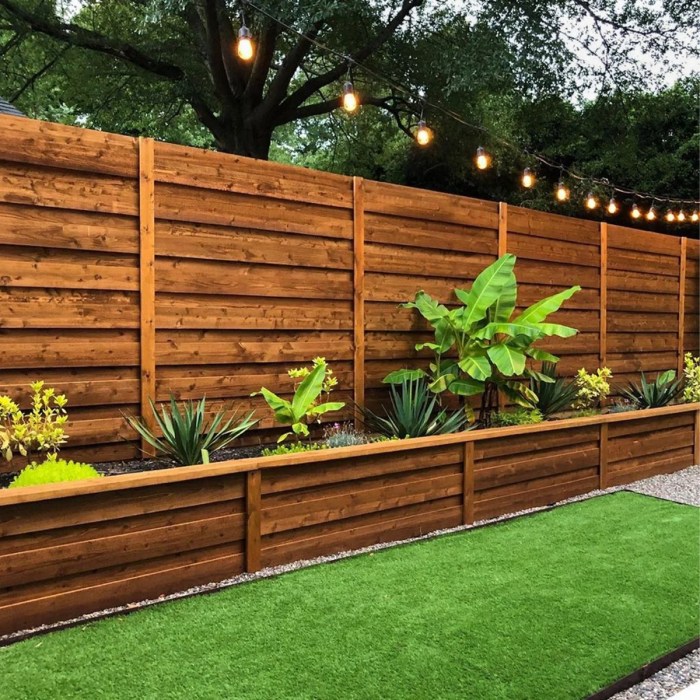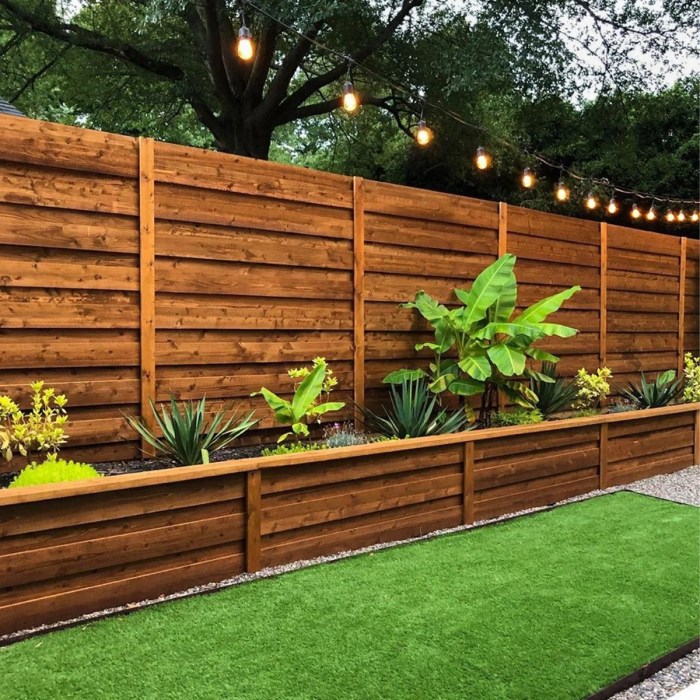DIY fence panels offer a fantastic way to enhance your property’s privacy, security, and aesthetics. Whether you’re seeking a classic wooden fence, a low-maintenance vinyl option, or a durable composite choice, the world of DIY fence panels presents a multitude of possibilities. This guide will lead you through the entire process, from planning and material selection to installation and maintenance.
Table of Contents
Building your own fence can be a rewarding project, allowing you to customize your outdoor space and create a unique look. This guide will cover the essentials, providing detailed information on each step, from understanding the different types of panels to choosing the right tools and materials.
Planning Your Fence Project

Building a fence is a significant project that requires careful planning to ensure a successful outcome. By taking the time to plan, you can avoid costly mistakes and ensure that your new fence meets your needs and complements your property.
Determining Fence Dimensions, Diy fence panels
Before you begin building your fence, you need to determine the exact dimensions of your fence. This includes measuring the length, width, and height of the area you want to enclose. Accurate measurements are essential for calculating the number of fence panels and posts you will need.
- Measure the perimeter: Use a measuring tape to determine the total length of the area you want to enclose. Make sure to measure along the outside of the area, taking into account any curves or angles.
- Consider gate placement: If you plan to include a gate in your fence, factor in the width of the gate opening when measuring the perimeter.
- Determine fence height: The height of your fence will depend on your specific needs and local building codes. Consider factors such as privacy, security, and the height of existing fences in your neighborhood.
- Choose panel size: Fence panels are typically available in standard sizes, such as 6 feet or 8 feet in length. Select a panel size that will minimize waste and ensure a clean, consistent look.
Obtaining Necessary Permits
In most areas, you will need to obtain a permit before building a fence. This ensures that your fence meets local building codes and safety regulations. Check with your local building department to determine the specific requirements in your area. They will be able to provide you with information on:
- Permit application process: This will likely involve submitting a plan of your fence and providing details about its materials and dimensions.
- Building codes: Local building codes may specify requirements for fence height, materials, and setback distances from property lines.
- Inspection requirements: You may need to have your fence inspected by a building inspector to ensure it meets code.
Designing a Complementary Fence
Your fence should complement the existing landscape and architecture of your property. Consider these factors when designing your fence:
- Style: Choose a fence style that complements the architectural style of your home. For example, a traditional home might look best with a picket fence, while a modern home might suit a contemporary fence with clean lines.
- Materials: Consider the durability, maintenance requirements, and aesthetic appeal of different fence materials. Popular options include wood, vinyl, and metal.
- Color: Choose a fence color that complements the color of your home and landscaping. Consider using a neutral color that will blend in with the surrounding environment.
- Gate design: The gate is an important design element that can add visual interest to your fence. Choose a gate style that complements the overall fence design and provides easy access to your property.
DIY Fence Panel Styles and Designs: Diy Fence Panels
The possibilities for DIY fence panel styles and designs are practically endless. From classic to contemporary, you can choose a style that complements your home’s architecture and personal taste. This section explores various options, including incorporating decorative elements, and using different colors, textures, and materials to create unique and personalized fence panels.
Traditional Fence Panel Styles
Traditional fence panel styles are known for their classic and timeless appeal. These designs often feature simple, straightforward structures that blend seamlessly with various architectural styles.
- Picket Fences: A quintessential American fence style, picket fences typically consist of vertical wooden slats (pickets) spaced evenly along horizontal rails. They can be painted in a variety of colors, from classic white to bolder hues, adding a touch of charm to any property.
- Post and Rail Fences: This style features sturdy posts supporting horizontal rails, often with decorative elements like rounded or pointed tops. Post and rail fences are durable and provide a rustic charm, ideal for properties with a country or farmhouse aesthetic.
- Board-on-Board Fences: A robust and visually appealing option, board-on-board fences use vertical boards that overlap, creating a solid and secure barrier. The overlapping boards add a unique texture and depth to the fence, making it a popular choice for privacy and aesthetics.
Modern Fence Panel Styles
Modern fence panel styles emphasize clean lines, minimalist designs, and innovative materials. They often feature geometric shapes, bold colors, and contemporary materials that create a sleek and sophisticated look.
- Metal Fence Panels: Metal fence panels offer a modern and durable solution, available in various materials like aluminum, steel, and wrought iron. These panels come in a range of styles, from simple and sleek to intricate and decorative.
- Composite Fence Panels: Combining wood and plastic, composite fence panels offer the look of wood with enhanced durability and low maintenance. They are available in various colors and textures, allowing for a modern and elegant appearance.
- Glass Fence Panels: For a truly contemporary look, consider glass fence panels. They provide an unobstructed view while offering privacy and security. Glass panels are often used in conjunction with metal framing for a modern and stylish design.
Contemporary Fence Panel Styles
Contemporary fence panel styles blend elements of traditional and modern designs, creating unique and visually appealing options. They often incorporate innovative materials, bold colors, and intricate details, reflecting current trends in design and architecture.
- Horizontal Fence Panels: A popular contemporary choice, horizontal fence panels feature boards or slats placed horizontally, creating a clean and modern aesthetic. They can be made from wood, metal, or composite materials, and often come in a variety of colors and finishes.
- Geometric Fence Panels: Geometric shapes, like squares, triangles, or circles, are incorporated into contemporary fence panel designs, adding visual interest and a modern touch. These panels can be made from wood, metal, or composite materials and often feature bold colors and contrasting textures.
- Slatted Fence Panels: Slatted fence panels offer a unique and modern look, featuring narrow vertical slats spaced apart to create a sense of openness and light. They are available in various materials, including wood, metal, and composite, and can be painted in a range of colors to complement any design style.
Adding Decorative Elements
Incorporating decorative elements is a great way to personalize your fence and enhance its visual appeal. These elements can range from simple accents to intricate details, adding a touch of style and character to your property.
- Latticework: Latticework panels can be used to create privacy screens, accent walls, or decorative accents along your fence. They are available in various designs and materials, including wood, metal, and vinyl.
- Pickets: Pickets are classic decorative elements that can be used to create a variety of patterns and designs. They are available in various shapes, sizes, and materials, allowing for a wide range of customization options.
- Planters: Adding planters to your fence is a great way to incorporate greenery and add a touch of color. You can choose from a variety of planter styles and sizes to complement your fence and garden design.
Color, Texture, and Material Considerations
Choosing the right colors, textures, and materials can significantly impact the overall look and feel of your fence. Consider these factors when selecting your materials and designing your fence panels.
- Color: Color plays a significant role in creating visual appeal and setting the tone for your property. Consider the color scheme of your home, surrounding landscape, and personal preferences when choosing a color for your fence.
- Texture: Texture adds depth and visual interest to your fence. You can choose from smooth, rough, or textured materials, such as wood, metal, or composite.
- Material: The material you choose for your fence will influence its durability, maintenance requirements, and aesthetic appeal. Consider the climate, budget, and desired style when selecting your materials.
DIY Fence Panel Safety Considerations

Building a fence is a rewarding project, but safety should always be your top priority. Whether you’re a seasoned DIYer or a first-timer, taking the necessary precautions can prevent injuries and ensure a smooth, successful fence installation.
Protective Gear
It’s crucial to wear appropriate protective gear when working with DIY fence panels. This helps safeguard you from potential hazards and minimizes the risk of injuries.
- Safety Glasses: Protect your eyes from flying debris, sawdust, and other projectiles.
- Work Gloves: Provide grip and protect your hands from splinters, cuts, and abrasions.
- Hearing Protection: Reduce the risk of hearing damage, especially when using power tools.
- Closed-Toe Shoes: Protect your feet from falling objects and sharp materials.
- Dust Mask: Prevent inhaling sawdust and other airborne particles, especially when cutting or sanding wood.
Lifting Techniques
Proper lifting techniques are essential to avoid back injuries and strains.
- Bend your knees: Use your leg muscles to lift, not your back.
- Keep your back straight: Avoid twisting or bending your back while lifting.
- Get a good grip: Use a firm grip on the fence panel to maintain control during lifting.
- Ask for help: If the fence panel is heavy, ask someone to assist you.
Potential Hazards and Mitigation
Identifying potential hazards and taking appropriate measures to mitigate them is crucial for a safe DIY fence project.
- Power Tools: Always use power tools with caution and follow the manufacturer’s instructions. Regularly inspect tools for damage and ensure they are in good working order.
- Sharp Objects: Be mindful of sharp edges on fence panels, tools, and materials. Use gloves and handle them with care.
- Falling Objects: Securely support fence panels while working to prevent them from falling and causing injury.
- Uneven Terrain: Be aware of uneven terrain and potential trip hazards. Wear appropriate footwear and maintain a stable footing.
- Weather Conditions: Avoid working in extreme weather conditions, such as rain, snow, or high winds. These conditions can create slippery surfaces and make it difficult to work safely.
With a little planning and effort, you can create a beautiful and functional fence that will enhance your property for years to come. Remember to prioritize safety, follow the instructions carefully, and enjoy the satisfaction of completing a DIY project that adds value to your home.
Building DIY fence panels can be a rewarding project, allowing you to customize your outdoor space to your liking. While working on your fence, you might also find yourself considering other DIY projects for your furry friend, like a DIY dog washer. A dedicated dog washing station can save you time and mess, and it’s a great way to keep your pup clean and happy.
Once your fence is up and your dog is sparkling clean, you’ll have a beautiful and functional outdoor space for both you and your canine companion.


